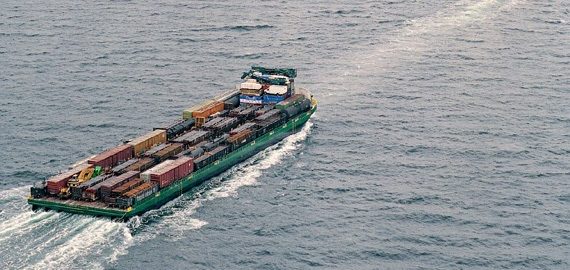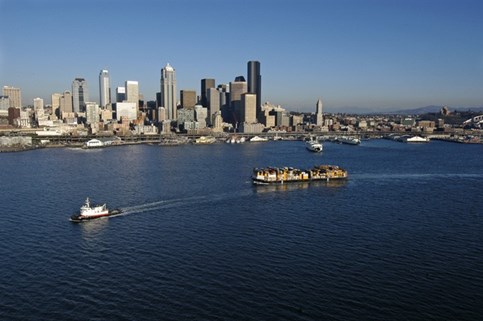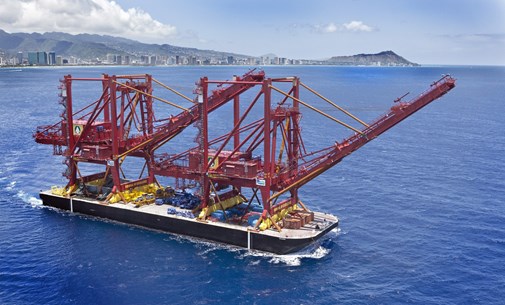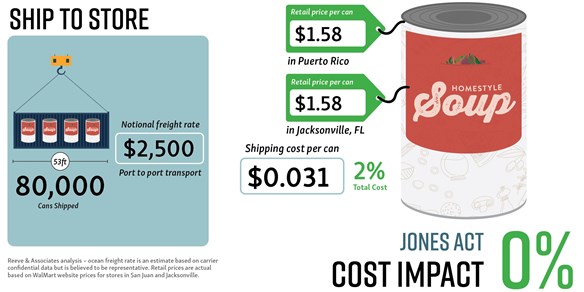
It comes as little surprise that the United States is the world’s largest trading nation. Less known is that a large part of U.S. trade is done by water. Serving as vital protection for this industry, the Jones Act is a maritime regulation established in 1920. It requires that any vessel shipping goods from one U.S. port to another must be built, owned and operated by United States citizens. When created, the intent of the Jones Act was to strengthen the domestic shipping industry after World War I. Today, it continues to play an integral role in the U.S. economy, with the West Coast being a large contributor to this maritime activity. This includes Portland, Oregon, the home of Greenbrier Marine.
The Jones Act has an impact on numerous industries across the U.S. It helps generate hundreds of thousands of employment opportunities, contributes billions of dollars to the economy, maintains high environmental quality standards, and increases U.S. presence and competitiveness in the shipping industry. National tugboat, towboat and barge advocate, The American Waterway Operators, claim “the entire ‘Jones Act fleet’ directly supports 500,000 American jobs and provides $100 billion in economic output.”[1] Furthermore, for every one direct maritime job, five indirect jobs are created.[2]
Cargo movement through the 29 West Coast ports[3] is tied to 12.5% of U.S. GDP, so for cities along the coastline, the Jones Act is especially crucial for employment and economic security. For example, in Portland, Greenbrier is the 4th largest public company in the area[4], providing over 1,100 local jobs. This makes up a large percentage of the 6,640 total domestic maritime industry workers in Oregon.[5]

Greenbrier Marine is located alongside numerous other manufacturing and shipping facilities, and has been operating in the north reach of the Willamette River since 1919, one year before the start of the Jones Act. Additionally, the adjacent Port of Portland ranks No. 1 on the West Coast for auto exports both domestically and internationally. They are also a leader in exporting agricultural products, and liquid, dry and mineral bulk.[6] Jones Act requirements help foster and protect this high level of economic activity and by meeting the stringent U.S. qualifications, our barges become more competitive. Jones Act vessels have dual functions: they may be used domestically and internationally, while other non-Jones Act vessels remain more limited in their shipping capacity.
Barge manufacturing is labor-intensive: it demands a high volume of employees with a specific technical skillset. A significant benefit from Jones Act is keeping the shipping industry and these trade skills alive in the U.S. According to Loren Thompson, Forbes Magazine journalist, only about 1% of the world’s large commercial vessels are constructed by the U.S., and most of them utilize Jones Act routes. While 1% may appear nominal, there could be repercussions from a complete withdrawal from the Act. Thompson stated “In the absence of the Jones Act protections, the U.S. would likely exit the business entirely – destroying tens of thousands of jobs in shipyards, in the supply chain, and in repair centers along nation’s coastlines”.[7] In order to protect the independence of the U.S. shipping industry, it is important to have those skills available domestically instead of outsourcing production to foreign operators. Ceasing to use the Jones Act could stifle employment opportunities as well as impair several sectors across the U.S. economy.

Some of the most common debates about the Jones Act revolve around high costs to run American shipyards, which has been argued will translate to disproportionately expensive products in island states and territories. While at the surface level, American shipyards are more expensive to run, in reality, the difference in shipping costs to these surrounding territories is slim to none. One reason for shipyards costing more at home is that American government provides fewer subsidies than foreign competitors. By comparison, the South Korean government has provided $22 billion in subsidies for its shipbuilding industry.[8] This takes economic pressure off of small shipping companies and allows for more flexibility in freight costs. The Jones Act fleet is also held to higher environmental and safety laws than foreign competitors with strict maintenance requirements and frequent inspections, which increases the cost of operations. However, waterborne commerce is more fuel efficient and emits fewer pollutants than its land-based counterparts. Without waterway shipping, heavy truck traffic on highways would nearly double, so the cost to repair and maintain highways, as well as combat the increase in air pollution, would introduce a new economic burden.[9]
The claim that the cost of goods are more expensive to island states is misguided. One of the most highly scrutinized cases of high costs being placed onto consumers is demonstrated by Puerto Rico, particularly after the effects of Hurricane Maria in 2017. Despite the common criticisms of the Jones Act negatively impacting Puerto Rico’s economy, a recent study done by Reeve & Associates and Estudios Técnicos, Inc. determined that the Jones Act actually has no impact on retail prices or the cost of living on the island. In fact, after extensive price comparisons between consumer goods in San Juan, Puerto Rico and Jacksonville, Florida, they found that island prices remained consistent with those on the mainland. The Act also contributes over 1,000 jobs to island residents and $250 million to the commonwealth.[10]

Finally, it is difficult to say how much of a difference removing the Act would genuinely make on product delivery. According to the Reeve & Associates and Estudios Técnicos study, “57% of San Juan’s port traffic in 2016 was carried on foreign vessels…There is nothing in the Jones Act that precludes foreign-flag vessels from serving Puerto Rico directly from foreign countries”.[11] This directly refutes arguments about the Jones Act negatively impacting the economy. In addition, on numerous occasions over the last decade, Jones Act requirements were waived in order to quickly deliver products to areas affected by hurricanes. Even with the 2017 waiver for Hurricane Maria, only one foreign vessel took advantage.[12] On the other hand, at any given time between 15 and 25 Jones Act vessels delivered 11,300 containers with millions of pounds of relief and other supplies to Puerto Rico within the first 12 days.[13]
For nearly a century, the Jones Act has helped provide the U.S. with the security of a competitive shipping industry, job opportunities, immediate relief aid and significant contributions to the economy at large with Portland, Oregon being just one of the many beneficiaries. Maintaining safe, environmentally friendly, and reliable trade standards between U.S. ports is a fundamental quality of the Act and we, at Greenbrier, are proud to play a part by producing high quality marine vessels for shipping needs inside and outside of the U.S.
[1] Jones Act. (n.d.). Retrieved from https://www.americanwaterways.com/issues/jones-act
[2] The Jones Act. (n.d.). Retrieved from https://www.americanmaritimepartnership.com/ u-s-maritime-industry/the-jones-act/
[3] Pacific Maritime Association. Overview. (n.d.). Retrieved from http://www.pmanet.org/safety-and- security
[4] Brandon, Sawyer. “Largest Publicly Traded Companies in Oregon & S.W. Washington.” Bizjournals.com, The Business Journals, 21 June 2018, 3:00am, www.bizjournals.com/portland/subscriber-only/2018/06/21/largest-publicly-traded-companies-in.html
[5] Maritime in Your Community. (n.d.). American Maritime Partnership. Retrieved from https://www.americanmaritimepartnership.com/
[6] More than a Port, We are your partner. (n.d.). Retrieved from https://www.portofportland.com/Marine Copyright 2018
[7] Thompson, L. (2017, October 17). Why Repealing The Jones Act Could Be A Disaster For The U.S. Retrieved from https://www.forbes.com/sites/lorenthompson/2017/10/17/maritime-security-five-reasons-the-jones-act-is-a-bargain/#754cee083d96
[8] Position Papers. “Grennes’ Analysis of the Jones Act and Ship Safety Ignores the Facts” (2018, April 13). American Maritime Partnership. Retrieved from https://www.americanmaritimepartnership.com/position-papers/grennes-analysis-of-the-jones-act-and-ship-safety-ignores-the-facts/
[9] The Jones Act: The Foundation of the U.S. Domestic Maritime Industry. (n.d.) American Maritime Partnership. Retrieved from https://3snn221qaymolkgbj4a0vpey-wpengine.netdna-ssl.com/wp-content/uploads/2017/10/Jones-Act-is-Foundation-of-Domestic-Maritime_American-Maritime-Partnership.pdf
[10] Impact of the U.S. Jones Act on Puerto Rico (3). 2018, Impact of the U.S. Jones Act on Puerto Rico, 3snn221qaymolkgbj4a0vpey-wpengine.netdna-ssl.com/wp-content/uploads/2018/07/Report_Impact-of-the-Jones-Act-on-Puerto-Rico_FINAL.pdf. Study prepared by: Reeve & Associates and Estudios Técnicos, Inc.
[11] “New Report Finds Retail Prices in Puerto Rico Are Not Affected by the Jones Act.” American Maritime Partnership, 17 July 2018, www.americanmaritimepartnership.com/press-releases/new-report-finds-retail-prices-in-puerto-rico-are-not-affected-by-the-jones-act/. Study completed by Reeve & Associates and Estudios Técnicos, Inc.
[12] Transportation Institute. (n.d.). Jones Act. Retrieved from https://transportationinstitute.org/jones-act
[13] Impact of the U.S. Jones Act on Puerto Rico (23). 2018, Impact of the U.S. Jones Act on Puerto Rico, 3snn221qaymolkgbj4a0vpey-wpengine.netdna-ssl.com/wp-content/uploads/2018/07/Report_Impact-of-the-Jones-Act-on-Puerto-Rico_FINAL.pdf. Study prepared by: Reeve & Associates and Estudios Técnicos, Inc.

